If you thought all unmanned air vehicles (UAVs) were variations on the familiar fixed-wing autonomous aircraft then think again.
Working with $0.5 billion of US defence funding, a team of American and British engineers are developing a 300 ft long reconnaissance drone based on a class of vehicle that many regard as little more than an intriguing footnote in aviation history: the airship.
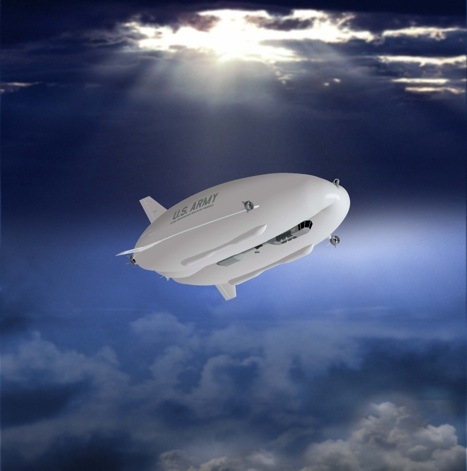
Dubbed LEMV (long endurance multi intelligence vehicle) the helium-filled drone will, when it takes to the skies sometime next summer, become the world’s longest endurance UAV. ‘[the] vehicle will stay airborne for 21 days, carry 2500 pounds of payload, and travel at speeds between 30 - 80 knots’ explained Alan Metzger, director for airship programmes at Northrop Grumman, which is heading up the project.
Bristling with reconnaissance systems, and autonomously operating at altitudes of around 22000 feet, the aircraft - the first of three similar three similar vehicles - is expected to make its maiden flight next summer and will be deployed in Afghanistan by January 2012.
It’s an ambitious timescale for any new vehicle. But the designers of the LEMV aren’t starting from scratch. Indeed, the vehicle will be based heavily on the Sky Cat, an advanced airship design refined over decades by UK firm Hybrid Air Vehicles Ltd (HAV).
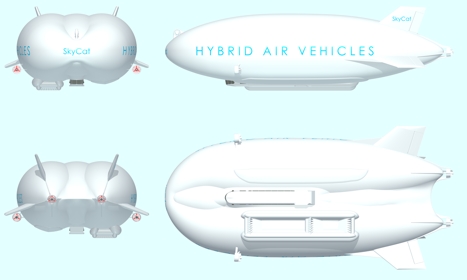
Based at Cardington in Bedfordshire - the spiritual home of UK airship design (see box) - HAV is, as its name suggests, a specialist in hybrid air vehicles, which, strictly speaking, aren’t pure airships but fly using a combination of aerostatic and aerodynamic lift.
HAV’s Gordon Taylor explained: ‘Firstly we get aerodynamic lift through the shape of the hull. The next element is vectored thrust: we have four diesel engines and a vector vane technology that allows us to manipulate those engines independently. The third element is aerostatic lift, from helium contained within the vehicles.’
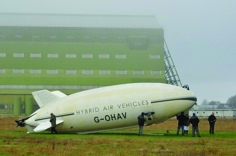
Northrop’s Metzger outlined a typical flight scenario: ‘We’ll use aerodynamic lift and vector thrust to get ourselves airborne - and burn a certain a mount of fuel - then at some point in the mission there’s a transition where the vehicle becomes lighter than air, the helium creates the predominant element of buoyancy and we’ll use our engines to manipulate about our mission space.’
This is going to be the longest endurance UAV in the world, it’s got the ability to stay up for three weeks with unblinking stare.Alan Metzger, Northrop Grumman
It’s an approach that gets around some of the fundamental problems of conventional airship design. ‘Traditional airships only float when they’re in equilibrium,’ said Taylor. ‘If you put ten people on board you’ve got to take ballast off before you go anywhere. Then, as you fly you burn off fuel becoming too light and making it hard to land: a hybrid overcomes these issues.’
According to Taylor, the technology is also the only credible candidate for long-endurance surveillance, a key capability in modern defence strategies. ‘Northrop Grumman build the most sophisticated UAV in the world - the Global Hawk. Why have they suddenly elected to come to us? The answer is simple: there is no other way to do it. The longest current endurance you calculate in hours but you don’t talk weeks, the only other thing you could contemplate would be a satellite.’
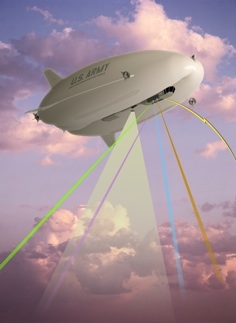
Metzger agrees that the vehicle has a number of huge advantages over fixed-wing UAV technology: ‘This is going to be the longest endurance UAV in the world, it’s got the ability to stay up for three weeks with unblinking stare. There will be no gaps in the data that gets put down to the war-fighter. I don’t know of anything equivalent that could stay up for three or four weeks.’
It is also, he said, relatively inexpensive to operate: ‘this can stay aloft for weeks on around 18,000lb of fuel. When you do the maths on that you’re talking about $20,000 to keep the vehicle in the air for three weeks. It’s vastly cheaper to operate than many conventional aircraft today.’
During operation the LEMV will typically fly in either an autonomous or remotely operated mode. However, because of its huge size, it has to be flown through civil airspace to conflict zones, which means that it must also have the capability to be manually piloted.
The flight control algorithms that will enable the vehicle to switch between these different modes are being developed by another UK firm - Blue Bear Systems Research.
Also based at Cardington, Blue Bear, which was spun out of the now defunct Defence Evaluation and Research Agency (DERA) in 2000, has plenty of experience developing flight control systems for fixed-wing UAVS. But according to one of the firm’s systems engineers Ken Wahren, the LEMV has presented an entirely new set of challenges. ‘Controlling an air-ship is much more like controlling a ship than fast fixed wing aircraft’ he said. ‘This means that things happen a lot more slowly but there’s also a certain inevitability. You can get away with data rates that are a lot lower but you have a lot more systems to manage and they are distributed right around the airship. Managing all of those subsystems to produce the desired control on the vehicle is quite a challenge.’
Another issue is that the large surface area of the vehicle makes it potentially more vulnerable than smaller fixed wing aircraft to strong winds. However, Taylor is confident that team will find a way around this. ‘Something in the 10 - 20 knot wind area is no kind of issue at all,’ he said. ‘Indeed the vehicle will lift and take off in much shorter distances. Ground handling in any type of windy condition could pose challenges, but nothing that we don’t believe is possible.’
This is not a hostile threat type of vehicle. It’s for command and control areas where we need persistent surveillanceAlan Metzger, Northrop Grumman
But if the wind isn’t a problem, what about enemy fire? Won’t a large, relatively slow-moving airship present a conspicuous target for Taliban trophy hunters?
According to Metzger, the vehicle is unlikely to be used in situations where this is a particular risk. ‘This is not a hostile threat type of vehicle,’ he said, ‘It’s for command and control areas where we need persistent surveillance. There are limitations to where you’d want to use it.’
If the vehicle does find itself in a flashpoint, Metzger’s confident that the its skin - a blend of Vectran, Kevlar and Mylar - will be able to cope with a reasonable amount of small arms fire. ‘It’s a woven fabric and has a lot of redundancy in it to mitigate tears, if one was to experience a bullet hole it’s not going to propagate the length of the hole. You may lose a little bit of helium but the pressure between the inside of the hull and the outside is not very great so a small anomaly like that is not going to cause any significant damage.’
What’s next
LEMV isn’t the only big airship program currently being funded by the US army.
Northrop Grumman’s biggest competitor Lockheed Martin was last year awarded a $400 million DARPA grant to develop a prototype reconnaissance airship able to stay in the stratosphere for years on end.
According to DARPA the ISIS airship would use 6000m2 of lightweight radar equipment to track everything from cruise missiles to small vehicles hidden in the undergrowth 300 kilometers away.
The platform will owe its remarkable capabilities to the physics of radar. The surface area and height of a stratospheric airship enables a very large radar aperture. As the radar aperture grows larger, the tracking performance of the radar system increases exponentially. Demonstration flights are planned for 2013.
LEMV is designed primarily as a surveillance vehicle and when it takes to the skies above Afghanistan a suite of radar, video and signal intelligence equipment will enable to focus its unblinking gaze on the terrain below.
However one of the big attractions of the technology is that this payload is adaptable. ‘One of the key things that army wants is the ability to rapidly integrate new payloads,’ said Metzger. ‘We know that the payloads we put on today may not be the payloads that we have a year or two from now because the fight will change.’
Metzger added that the flexibility of the vehicle could even lead to it being used for quite different applications, for instance transporting cargo or carrying heavy-lift applications. ‘Some of the characteristics of our vehicle allow you to make trades between how long you’d like to stay in the air and how much cargo you’d like to carry. we have the ability to trade 23 days to go 1000 miles and carry 15, 20, 30,000 pounds.’
We’re currently negotiating with an end customer and hope to sign a commitment to pursue heavy lift at FarnboroughGordon Tayor, Hybrid Air Vehicles
HAV’s Gordon Taylor is particularly excited about the technology’s potential for transporting freight. ‘With lighter than air vehicles the bigger we get the more efficient we get,’ he said. ‘We’re currently negotiating with an end customer and hope to sign a commitment to pursue heavy lift at Farnborough.’ He also revealed that his team is now working on the development of a hovercraft landing system for the vehicle. ‘It not only gives you a hover craft capability but we can reverse it to suck the vehicle to the ground when you’re discharging your load,’ he claimed.
‘It’s very hard to get people to accept all this,’ admitted Taylor, ‘so we pursued the one that we thought we’d get through first.’ When LEMV takes to the skies in a little over a year, he believes the compelling capabilities of lighter than air vehicles will be there for all to see. ‘We’re green, we use a quarter of the fuel as the same payload of cargo aircraft, we only use fuel to push us along, there are fewer moving parts. there’s less maintenance, it’s a new green form of transportation.
‘People have believed in this technology for years’, agreed Metzger. ‘Now we have the opportunity to show that a vehicle of this class and size can carry the required payloads, create the endurance and persistent surveillance that war-fighters are looking for.’
From the archive
In 1928 The Engineer visited Cardington to see airship R101 taking shape.
On Thursday of last week we were afforded an opportunity of making a detailed inspection of the rigid airship R101, now in course of construction at the Royal Airship Works, Cardington.
During our visit we inspected the metereological forecasting station which as been erected there, and were much impressed. Particular attention is being given to the study of thunderstorms over the route, not so much because of the danger of the airships being struck by lightning, but because of the very rapid vertical currents which occur during such storms.
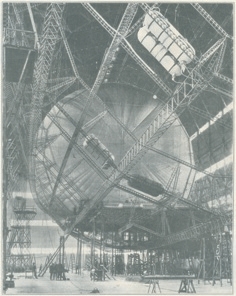
The general framework of the R101 will consist of sixteen vertical polygonal frames each having fifteen sides and being joined to its neighbours on either side by fifteen longitudinal girders which run continuously from end to end of the structure.
With the exception of the five engine cars and the control car all the accommodation will be within the hull structure. That will be concentrated on two decks. The lower deck will have an area of 1730 square feet. The upper deck will have an area of 5550 square feet.
The total fuel storage capacity of the aircraft will amount to 37 tons. As there has been a certain amount of discussion concerning the use of heavy oil engines in airships, it may here be noted that their use is claimed to increase the trustworthiness of the power equipment by eliminating carburettors and magnetos and to eliminate the fumes which in the past have proved a source of much unpleasantness and danger in petrol-driven airships.
We have been told on good authority that several enemy airships during the war were destroyed by incendiary bullets penetrating to the petrol laden atmosphere of the internal spaces rather than by piercing the hydrogen gas bags.
Sadly the R101 crashed in France on its maiden voyage, killing 48 people.




Red Bull makes hydrogen fuel cell play with AVL
Formula 1 is an anachronistic anomaly where its only cutting edge is in engine development. The rules prohibit any real innovation and there would be...